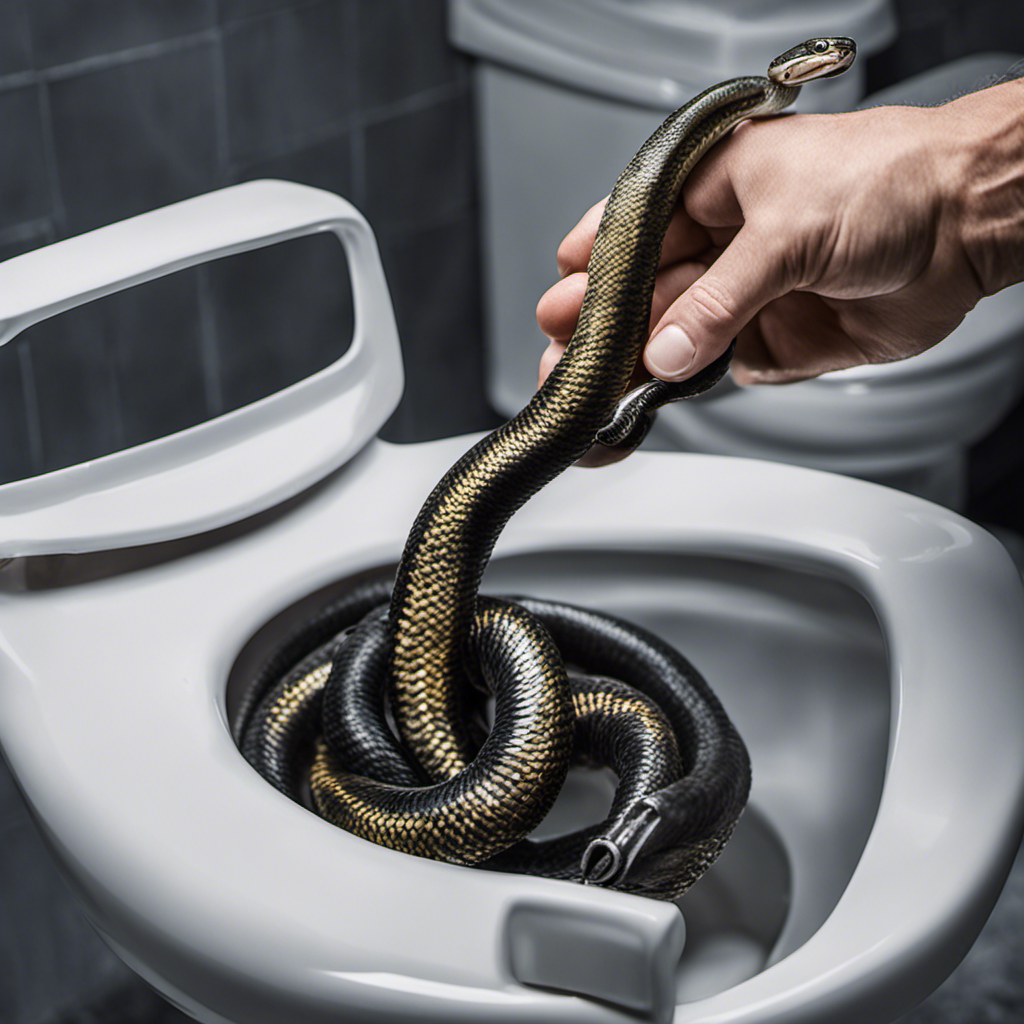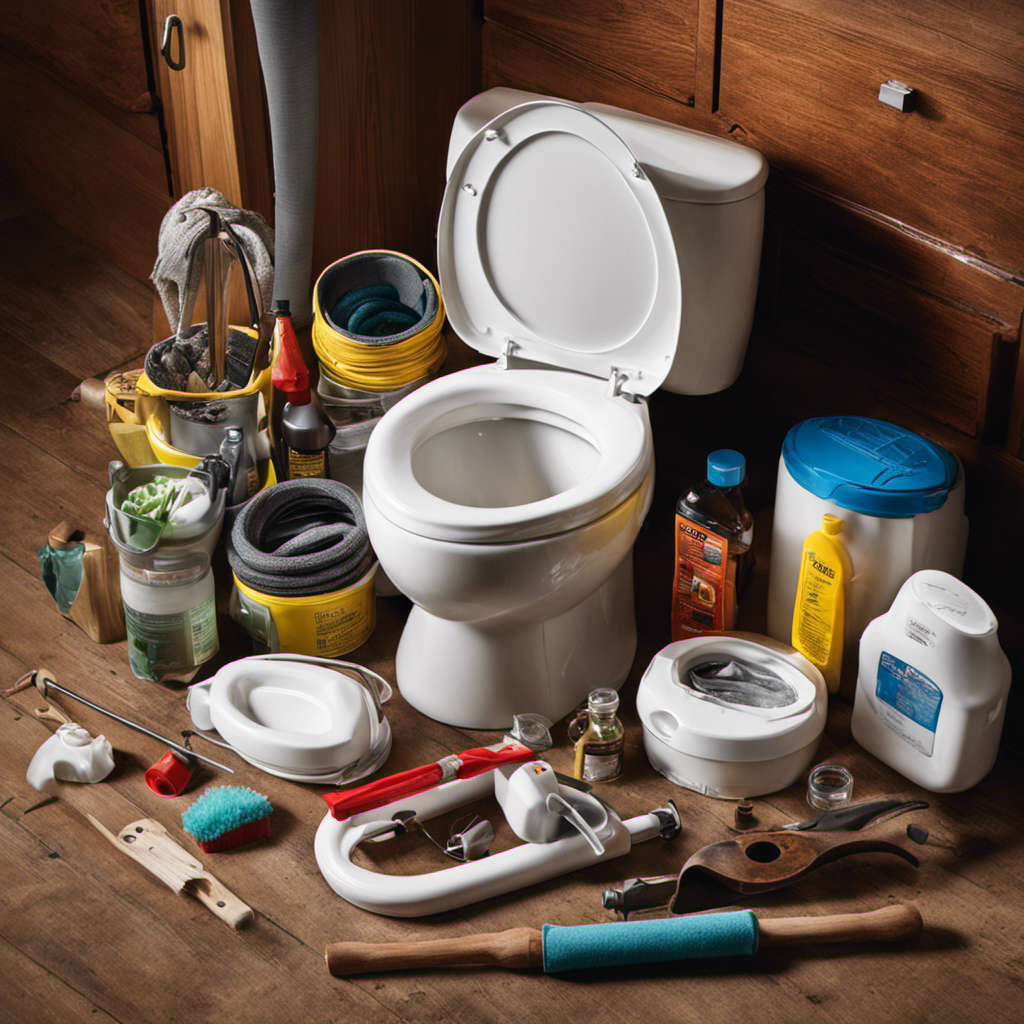As someone who has dealt with numerous toilet clogs, I can confidently say that using a toilet snake is a game-changer.
Did you know that nearly 20% of households in the United States experience a toilet clog at least once a year?
With the right technique and the proper tool, you can easily tackle this common plumbing issue yourself.
In this article, I will guide you through the step-by-step process of using a toilet snake, ensuring that you can unclog your toilet efficiently and effectively.
Key Takeaways
- Select the appropriate length and flexibility of the toilet snake for your plumbing system.
- Choose between a manual or electric toilet snake based on your preference and convenience.
- Properly insert and maneuver the snake, following safety precautions and avoiding excessive force.
- Clean the snake after each use and inspect for wear or damage, replacing if necessary.
Selecting the Right Toilet Snake
When selecting the right toilet snake, it’s important to consider the length and flexibility needed for your specific plumbing system. Choosing the best auger for your toilet can make all the difference in effectively clearing clogs. Understanding different types of toilet snakes will help you make an informed decision.
There are two main types of toilet snakes: manual and electric. Manual toilet snakes, also known as hand augers, are operated by hand and require physical effort to clear blockages. They are typically flexible and can navigate through bends in the toilet drain.
On the other hand, electric toilet snakes are powered by electricity and offer a more convenient option. They can be operated with the push of a button and are especially useful for tough clogs that require more power.
Consider the length of the toilet snake as well. Longer snakes are better suited for deeper clogs, while shorter ones work well for shallow blockages.
Preparing the Toilet for Snake Usage
Before starting, make sure the bathroom is clear and there is enough space to maneuver.
When it comes to unclogging a toilet, there are alternatives to using a traditional toilet snake. These alternatives include using a plunger, a drain auger, or even a mixture of baking soda and vinegar.
However, if you choose to use a toilet snake, there are some best practices to keep in mind.
First, make sure you have the right type of snake for the job. There are different sizes and lengths available, so choose one that is appropriate for your toilet. Additionally, be mindful of the material your toilet is made of, as certain snakes can cause damage to porcelain.
In the next section, we will discuss the proper techniques for inserting the snake into the toilet and effectively clearing the clog.
Proper Techniques for Inserting the Snake
To effectively clear the clog, it’s important to ensure the snake is inserted properly into the toilet. When using a toilet snake, it is crucial to follow the necessary safety precautions to prevent any accidents or damage.
First, make sure to wear protective gloves to avoid any contact with waste materials. Next, position yourself in a stable and balanced manner to maintain control of the snake.
When inserting the snake, gently push it into the drain and twist it clockwise to catch the clog. Avoid applying excessive force as it may damage the plumbing system. Additionally, be cautious not to scratch the porcelain surface of the toilet bowl with the snake.
Maneuvering the Snake Through the Toilet Drain
As you maneuver the snake through the toilet drain, be sure to twist it gently to navigate around any bends and obstacles. This technique is crucial to effectively clear any clogs or blockages in your toilet.
To maintain your toilet snake and ensure its longevity, it’s essential to clean it thoroughly after each use. This can be done by rinsing it with warm water and soap, ensuring all debris and residue are removed. Additionally, inspect the snake for any signs of wear or damage and replace it if necessary.
When it comes to toilet snakes, there are different types available, such as the handheld manual snake and the electric-powered snake. Each type has its advantages and should be chosen based on the severity of the clog and personal preference.
Troubleshooting Common Issues During Snake Usage
If you encounter any problems while using the snake, check for any tangles or knots in the cable.
Troubleshooting snake blockages is crucial to ensure effective clearing of toilet clogs.
Firstly, make sure the snake is inserted properly into the toilet drain. If you feel resistance, gently rotate the snake clockwise to break through the blockage.
If the snake gets stuck, avoid forcing it as this may damage the toilet bowl. Instead, try retracting the snake slightly and then pushing it forward again.
If the blockage persists, you may need to remove the toilet and access the drain from below.
Removing the Snake and Cleaning Up Afterwards
After unclogging the toilet, remember to carefully remove the snake and clean up any debris left behind. Cleaning up properly is crucial to maintain hygiene and prevent any unpleasant odors. Here are some important steps to follow:
-
Gloves: Put on a pair of disposable gloves to protect your hands from contact with any waste or bacteria.
-
Cleaning Tools: Use a toilet brush and disinfectant cleaner to thoroughly clean the inside of the toilet bowl. Pay extra attention to the area around the drain where the clog occurred.
-
Disposal Methods: Wrap the snake in a plastic bag or newspaper before disposing of it in a garbage bag. Make sure to tie the bag securely to prevent any leaks.
-
Sanitization: Wash your hands thoroughly with soap and warm water to ensure proper hygiene.
Tips for Preventing Future Toilet Clogs
To prevent future toilet clogs, it’s important to be mindful of what you flush down the toilet. By following a few simple tips, you can maintain the efficiency of your toilet and avoid costly repairs.
First, never flush anything other than toilet paper and human waste. Items like paper towels, feminine products, or wipes can easily clog your pipes. Additionally, consider using less toilet paper to reduce the risk of blockages.
Second, maintain your toilet regularly by inspecting the flushing mechanism and ensuring it is functioning properly. If you notice any issues, such as weak flushing or slow drainage, address them promptly.
Lastly, educate everyone in your household about proper toilet usage to prevent accidental clogs.
Conclusion
In conclusion, using a toilet snake can be a messy yet effective solution to unclogging your toilet.
As I maneuvered the snake through the drain, I could feel the power of the tool, like a skilled surgeon delicately untangling a web of complications.
The satisfaction of removing the snake and witnessing the clear flow of water is unparalleled.
Remember to clean up thoroughly and take preventive measures to avoid future clogs.
With the right technique and the right tool, you can conquer any toilet clog with confidence.










